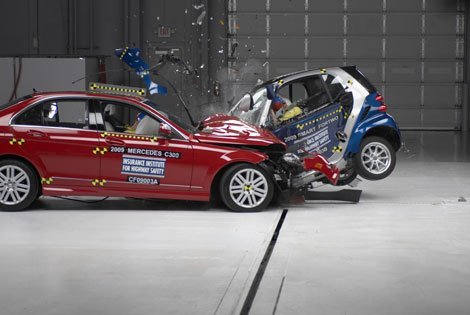Here Are the Safest and Most Dangerous Cars on the Road

The Insurance Institute for Highway Safety issued findings Thursday from a study that examined the death rates for vehicles from the 2011 model year. Overall, they determined that new cars are offering significant new protections for motorists.
In a three-year span, the average death rate fell from 48 fatalities per million vehicles registered in 2008 vehicles to 28 fatalities per million registrations in 2011 vehicles, a decrease of more than 41 percent.
"This is a huge improvement in just three years, even considering the economy's influence," said David Zuby, the executive vice president and chief research officer at IIHS. "We know from our vehicle ratings program that crash-test performance has been getting steadily better. These latest death rates provide new confirmation that real-world outcomes are improving too."
Safest, Most Dangerous Models
If there's a caveat to that, it's that improvements aren't benefiting all drivers.
The 2011 Kia Rio had the highest rate of death, with 149 fatalities expected per million registrations. The Nissan Versa sedan had 130 fatalities per million registered and the Hyundai Accent had 120 fatalities per million registered. They were the deadliest cars in the study.
On the safest end of the spectrum, nine models had a death rate of zero:
- Audi A4 4WD,
- Honda Odyssey,
- Kia Sorento 2WD,
- Lexus RX 350 4WD,
- Mercedes-Benz GL-Class 4WD,
- Subaru Legacy 4WD,
- Toyota Highlander Hybrid 4WD,
- Toyota Sequoia 4WD, and
- Volvo XC90 4WD.
When the IIHS researchers conducted the same study eight years ago, there were no vehicles that had a death rate of zero. Improvements are coming from both an external push from safety advocates to eradicate traffic deaths and from technology advances in the vehicles themselves.
"The complete elimination of traffic deaths is still many decades away, and along with vehicle improvements, getting there will require changes in road design and public policy that can help protect all road users," Zuby said. "Still, the rise in the number of vehicles with zero driver deaths shows what's possible."
Technology Drives Improvement
IIHS tabulated its results by examining fatality data from the National Highway Traffic Safety Administration and registration data from R.L. Polk & Co. Researchers examined 2011 model-year vehicle data through the end of the 2012 calendar year. The results examine drivers only, not all vehicle occupants.
A related IIHS study shows that technology improvements are the main reason for the decline in deaths. Improved structures and the addition of safety features saved approximately 7,700 lives in 2012 alone compared to the number that would have died had there been no technology changes since 1985. While safety-conscious car shoppers should no doubt check the full results for make-and-model information, there are some general trends in the data that are not surprising.
Cars are still susceptible to physics: Bigger cars proved safer than smaller ones. Vehicles that fall into the IIHS' "mini" four-door category, for example, averaged 115 deaths per million registrations. As the cars get bigger, they generally get safer. "Small" four-door cars averaged 51 deaths per million registrations; "midsize" had a rate of 29 fatalities per million registrations; "large" four-door cars 34 deaths per million registration and "very large" 24 deaths per million registrations.
Four-wheel drive also seemed to be a difference maker. Thirteen of the 19 safest models in the study contained this feature, while only one of the 19 most dangerous cars – the '11 Chevrolet Silverado 1500 Crew – had four-wheel drive.
Related News


